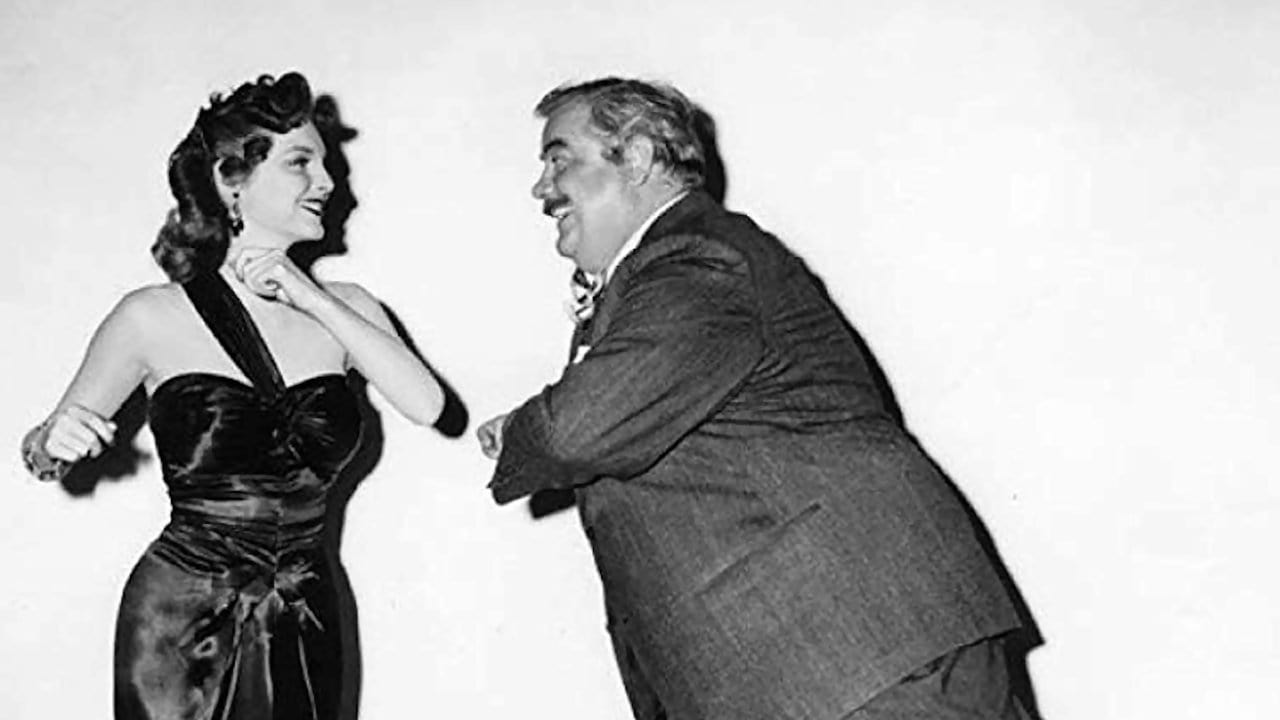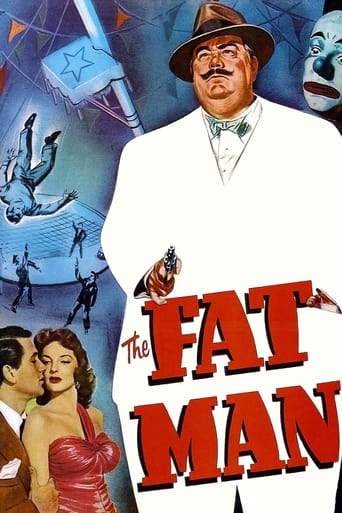



Redundant and unnecessary.
Dreadfully Boring
It's not great by any means, but it's a pretty good movie that didn't leave me filled with regret for investing time in it.
View MoreThe movie is surprisingly subdued in its pacing, its characterizations, and its go-for-broke sensibilities.
View MoreWilliam Castle is today mostly remembered for his clever exploitative gimmicks, which made horror films like "Macabre," "House on Haunted Hill," "The Tingler," etc., both terrifying and fun. But he started out making movies in another tradition—noir. Without gimmicks.In 1951's low-budget "The Fat Man," made for Universal, Castle borrows from another medium, taking a popular radio mystery program and transforming a broadcast melodrama into an exciting yet droll movie thriller, with unexpected pleasures.His lead, the basso profundo J. Scott Smart, is exceptionally good in his role as Brad Runyon, alias The Fat Man, a private detective who is not your average PI. Brad is a well-spoken, well-read, pleasure- loving, sweet-tempered, middle-aged, 270-lb mountain of a man wearing a quirky moustache right out of a Nineteenth-Century daguerreotype. However, The Fat Man is neither a hog nor a dunce. J Scott Smart's full and fine performance turns an unconventional private eye into a charming and intelligent investigator who is much cleverer than anyone else around him. (He's also tough when need be, packing a snub-nosed .32, and even graceful when the occasion calls for it, wowing with his agile and bouncy, if pachydermic dance steps.)After her employer is found dead, dental nurse Jayne Meadows (in real life, married to pioneering late night TV host Steve Allen) seeks out the food-loving Fat Man, who, in an entertaining intro, is showing a collection – a mélange, if you will -- of a great many chefs how to not spoil the broth. Certain dental records are missing, and the nurse believes this may have something to do with the dentist's death. (Meadows plays the dental nurse with sympathy and with more than a little sadness.)The unusual details of the dentist's death and his nurse's obvious distress hit a nerve, and The Fat Man takes on the case for nothing! (Always interested in filling himself, he just can't brush off such a toothy puzzle.) The trail of the missing dental X-Rays leads Private Eye Runyon from New York City to California -- and to an ex-con, nicely played by a young Rock Hudson. A sensible professional, Runyon works closely with the police, who cooperate courteously, if warily. Detective Lt. Stark, well-acted by Jerome Cowan, who himself a decade earlier had played Sam Spade's doomed partner in "The Maltese Falcon," treats him as a colleague, a refreshing change from the usual movie thriller adversarial relationship of PI vs. police.However, another movie tradition, the great sleuth's assistant who is dumber than a pound of wet liver, is still upheld. In a nicely comic turn, Clinton Sundberg handles the chores this chowderhead is saddled with a sweet enthusiasm, submitting to all sorts of indignities with a cheerful grace. Take note that nowhere in this movie does he get a salary check or even a tip.But The Fat Man has more to worry about than meeting a payroll. He has to sift through a couple more murders, outsmart a den of thieves, figure out the answers to an unsolved half-million-dollar armored car heist involving a posse of rent-a-cops, and face a mysterious, rather scary pratfall of clowns. (In much more than the usual gratuitous guest-star appearance, famous clown Emmett Kelly pops up here in a fully-realized three-dimensional portrayal. He even speaks – and well, at that!) The plump private eye is put on the trail of a night-club entertainer played by the sultry Julie London, who possesses a valuable secret. Vulnerable under her veneer of hardness, the sensual beauty, who, in real life, was married to TV cop Jack Webb, sends Runyon in the right direction, leading eventually to an exciting show-down which is both scary and surrealistic.Cameraman Irving Glassberg (celebrated for being one of the discoverers of Clint Eastwood) allocates his limited budget prudently, nourishing the film's noirishness with skill and finesse. His intelligent camera moves restlessly across patterned floors, picking up random gleams from the polished glass and metal of an elegant hotel lobby late at night, the few humans abroad seen as ominous shadows. A circus subtheme effectively adds still another dimension to the film. At one point, for instance, the Fat Man rents a British two- seat sports car -- an MG or a Morgan -- that looks like it may be too tiny for a five-year-old, let alone a behemoth like himself. As he shoehorns himself into the tiny car, which isn't much more than a roller skate with a motor, you can practically hear it groan. The camera mercifully looks away, before we learn how he manages to squeeze out of it. In another telling, even unsettling scene, what looks to be a whole platoon of bank guards in black SS-like uniforms tumble out of an armored truck, like one of those teeny-weeny circus clown cars that can hold an entire sideshow of grease-painted circus clowns plus their painted poodles and made-up monkeys plus a lifetime supply of inflated balloons . Filmed only a few years after the Second World War, in crisp black and white, "The Fat Man," though an unpretentious B movie that sort of got lost in the crowd, is a rich chowder of admirable acting and appealing directorial details. Without gimmicks.
View MoreJ. Scott Smart is pretty hefty without being morbidly obese. Some jokes are made about his girth and his love of good food because this was back in the day when jokes could still be made about people who were different from the stereotypical American. As a motion picture actor, he has the charisma of a damp rag.It's a routine B movie, a screen adaptation of the radio show popular at the time. Not much effort has gone into it. A nice dentist has been coshed and his body thrown out a window. It looks like suicide to the police but the dentist's assistant, Jane Meadows (looking fine), suspects there was more to it. The dental records and X rays of a certain Roy Clark (Rock Hudson, as good as he'd ever been) are missing. So what's up? The investigation takes Smart from New York to Los Angeles where he runs into varied characters, as is usual in these stories, except for two Jewish truck driver who have sharp, witty dialog and deliver it well but are directed a lento. The major characters like Julie London (yum) have flashbacks. ("I remember the first time I met Roy...") There's nothing notable about any of them. The attempts are humor are pedestrian.The clotted plot leads to a shoot out at the end, with the killer trapped inside a circus big tent at night. It looks like curtains for the clown. But no! He uses one of the prop cannons to turn himself into a human cannonball, launches himself through the air, and lands on a blue and yellow plastic blow-up raft in the form of a grinning horse, just a few yards off the beach at the resort town of Cancún, Mexico, where waiters immediately rush out and ply him with piña coladas and seviche. He adopts a NeutraSlim diet, loses one tonne, and finds himself surrounded with tan and radiantly healthy bikini-clad blonds. He forgets all about the Fat Man, and maybe you should too.Anyway, it all ends properly.
View MoreThe odd subtexts for this film are probably what has buried it. 1. It is based on a popular radio show that sold itself as "created by Dashiell Hammett." Actually the nickname "Fate Man" was that of Gutman, one of the baddies in the Maltese Falco; the character of the radio "Fat Man" was developed out of the otherwise nameless Hammett character "The Continental Op," hero of the Dain Curse and Red Harvest. But in 1951, when this film was about to be released, Hammett was getting sent to prison for thumbing his nose at the McCarthy-era 'House UnAmerican Activities Committee' witchhunters, so his name doesn't appear in the credits (at least not the copy I've seen). 2. With reference to Hammett removed, the character is redefined; while the character remains a tough private eye, he now has acquired a gourmand's taste for good cooking - an obvious reference to the popular Nero Wolfe Character - as well as a shadow of Wolfe's sidekick, Archie Goodwin. 3. This is an early film with Rock Hudson, and it is clear where he was intending to go with his career - a Montgomery Clift without the angst - but just as clearly he decided to change directions - too bad, he's actually quite good in this. 4. This is William Castle before he decided to throw himself wholeheartedly into gimmicky horror movies, and it reminds us that he could be a very capable director when he wanted to be. 5. That the a lead baddie is played by legendary clown Emmett Kelly probably doesn't mean much today, but it's certainly worth a footnote for those interested in the history of clowns. The story, dialog and acting are all solid; the camera-work, lighting and design are nothing special but certainly competent. The pacing is pretty good. The film keeps its suspense up and provides enough twists to be a real detective mystery. Overall a satisfying mystery from the era when such could still be made.
View MoreWhen I was growing up, pre-television, we used to listen to many radio shows. One of these was The Fat Man, starring J. Scott Smart. This, as with some other radio shows, was made into a movie. The casting of Smart in the title role was good, since he looked the part and the sound was identical to the radio program.In virtually every radio show, Bradford Runyan is hired to solve a crime; the film carries on the tradition. However, the radio program lasted for only a half hour, and even though there was a "time compression" effect, there was time to do significantly more in the film. As an example, Runyan asks a lady to dance, and when she accepts, he acquits himself well. That could never have worked on the radio program, to be sure.For those of us who remember the program, there's a lot of nostalgia in the film. For those who never heard the show (such as my wife), it's still okay, but probably not as valued.
View More